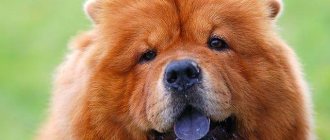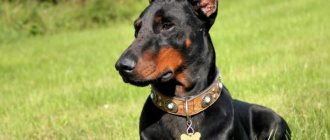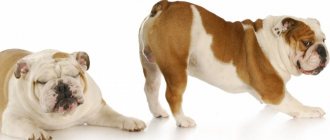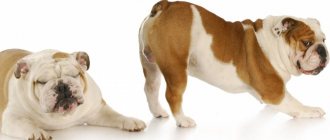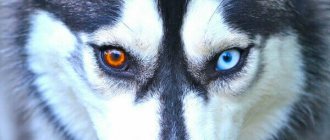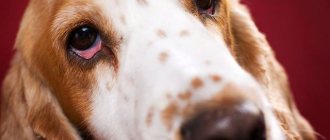In recent years, Siberian Huskies have gained popularity among dog breeders around the world, and simply among those who are not indifferent to these faithful friends and human companions. And this is not surprising, because this is a very charismatic, majestic and loyal breed of dogs, the individuals of which also have a unique exterior. The color of the eyes also gives dogs of this breed a special coloring of their appearance. Once you have seen the eyes of a Husky, it is simply impossible to forget this wolf-like, stern and, at the same time, devoted look!
Breed standard
It is impossible to meet identical huskies. Dogs have traits that set them apart from other dogs, but there are standard characteristics that are common to any type of this breed.
| Parameter | Males | Bitches |
| Height (at withers) | 55-60 cm | 50-55 cm |
| Weight | 20-30 kg | 15-24 kg |
| Head | Proportional to the size of the body, the skull is rounded at the top | |
| Eyes | Almond-shaped, medium. Color blue, brown, | |
| Muzzle | Standard size, tapers towards the nose | |
| Ears | Large in relation to the entire head, close to each other. The tips point upward and are slightly rounded | |
| Nose | The color depends on the color of the coat. Dark is typical for gray, black, red dogs; brown occurs in orange, flesh-colored, white and gray individuals | |
Expert opinion
Anna Abramenko
An avid dog lover. Experience in veterinary medicine since 2009.
Ask a Question
Scientists at the University of Alaska have proven that husky fur is an indicator of the presence of mercury.
Controversial and rare suits
White
Pure white huskies are rare. It looks especially effective if the dog has blue eyes.
When the white color is the result of a strong lightening of the piebald, the dog will have barely noticeable colored hairs around the eyes, on the rump and ears.
Black
Siberian Huskies do not have completely black colors (another name for Afro). For a suit to be recognized as such, it must be at least 75% dark in color. Light blotches are allowed on the limbs, chest, and tip of the tail; a white stripe is possible on the muzzle.
Black and tan
A relatively rare suit, it is also called tricolor or tricolor. The undercoat is brown, the guard hair is predominantly black, and tan – reddish-peach markings – are found on the chest, muzzle and paws.
Sable
Similar to a wolf, but with a bright red or copper undercoat. The color of the guard hair is unusual: it is black at the tip and fawn in the middle. The inclusions are the same as with the zonal suit, but more saturated, even dark brown.
Agouti
A very rare color, you can find it in working dogs living in the North. The guard coat is any shade of gray or black, a combination of both can form stripes on the body. The undercoat is light brown.
The key differences between the agouti color are the black tassel of the tail and the dark mask that fills almost the entire muzzle. Occasionally you come across dogs with white and red markings interspersed in their masks.
Cheprachny
Another designation is saddled. The name speaks for itself - these huskies have a patch of brown, red, gray or black wool on their back, reminiscent of a saddle. In other places the coat is white or light shades.
Piebald
It is also called piebold. On a white background (at least 70%) there are colored markings from red to black. The spots are round and asymmetrical.
Splash coat
Similar to the piebald color, only there is a light “collar” around the neck. The spots are bright, of any color, monochromatic. The eyes are often bright blue.
Isabella
The Isabella color is close to white, but on the back (from the withers to the croup) the tips of the hairs are colored in light red, golden or fawn tones.
Breeders have different opinions regarding the Isabella color. Some consider it a separate color, others say that it is a white tone obtained as a result of lightening the piebald.
Marble
Another unusual suit, around which there is controversy. Marble or harlequin color cannot be confused with another: dark spots of different sizes are randomly scattered on a white background.
Common colors
Basic eye color:
- brown;
- blue;
- olive;
- amber;
- heterochromic.
Expert opinion
Anna Abramenko
An avid dog lover. Experience in veterinary medicine since 2009.
Ask a Question
Heterochromia is a phenomenon in which an animal or person has different eye colors.
| Iris pigment | Coat color |
| Blue | White, grey, black. A mixture of these colors |
| Brown | Dark, red, brown with light spots |
Blue eyes are outlined with thick eyeliner as standard, which gives the look a special expressiveness. Meeting a snow-white, blue-eyed puppy is extremely rare, so many are willing to pay a huge amount for such a dog. Dog handlers say that light-colored dogs with blue, warm eyes are the most welcoming and friendly with people.
Dogs with dark brown eyes are more common. At the same time, the brown iris comes in completely different shades, and sometimes is closer to black than to brown.
Huskies with heterochromia are of particular interest. A dog with a blue and brown iris looks incredibly exotic, which is why many people want to get just such a dog. Cynologists call animals with multi-colored eyes harlequins.
Heterochromia in Huskies is not a defect, but a normal phenomenon. Harlequinism does not in any way affect the behavior or health of the dog, so future owners have nothing to fear.
Features of the suit
The appearance of dogs of this color is, first of all, a light, aristocratic appearance. The dogs are active and love an active lifestyle and walks in the fresh air. They easily find a common language with other animals and are able to act together, for example, in a common team.
Males are rightfully considered stronger and more resilient. They are larger in size and have a more powerful backbone. Females, on the contrary, are more graceful and fragile, but female representatives of this color cannot be called weak.
Huskies are medium-sized animals with very thick hair and a dense undercoat. They have straight ears, and their tail is more like a huge feather. Dogs of average build, and with proper care and feeding regimen, do not suffer from excess weight. But all this is not the main thing when it comes to huskies. After all, the whole world fell in love with dogs not for their size, coat color or feather-like tail. A husky's pupils are a pet's real asset. They fascinate, impress, and sometimes their gaze sends a chill through your skin.
Predisposition to heterochromia
The irises of different eyes of a husky attract attention. One of the animal's irises is black and the other is blue. Heterochromia is observed in many living creatures, only for some it is very rare, while for huskies it is a common occurrence.
This is interesting: Diet for huskies
To find out the cause of heterochromia in a particular dog, you need to consult a doctor. In most cases, this is a hereditary predisposition that is transmitted at the genetic level.
Expert opinion
Anna Abramenko
An avid dog lover. Experience in veterinary medicine since 2009.
Ask a Question
There are no huskies with green eyes.
In addition to congenital heterochromia, multi-colored irises can be caused by:
- long-term use of medications;
- complications of serious illnesses;
- penetrating damage that changes not only the color, but also the shape of the eye;
- lack of melanin in the body.
Expert opinion
Anna Abramenko
An avid dog lover. Experience in veterinary medicine since 2009.
Ask a Question
In fact, only brown pigment is present in the structure of the iris of a purebred husky. If it is deficient, the dog's eye color becomes blue. Heterochromia appears when the pigment concentration is not the same.
A predisposition to heterochromia occurs most often in those dogs that were born by crossing blue-eyed and brown-eyed dogs. It should be borne in mind that when two harlequins interact, the probability of giving birth to a kakerlak dog is extremely low.
Photo and video review
The main characteristics of the Husky breed allow us to call dogs unique creatures. This can be seen in life, in photos, videos. Dogs in any of their manifestations attract attention.
People can rely on a pet when left alone with the harsh nature. Dogs will never abandon a person; they will warm him with their bodies.
Methods for determining eye color in husky puppies
Huskies change the color of their irises over the course of six months. Therefore, only after this period can we speak with confidence about the color of the dog’s eyes.
At birth, a puppy’s irises may be dark blue or light blue, but after a month their color will begin to actively change. Just like any animal, huskies open their eyes 21 days after birth, and the retina is formed after 40 days.
A popular theory has emerged that the Harlequin Husky brings happiness and good fortune to its owner. This statement has not been confirmed in any way, but if, when choosing a dog, the eye falls on an odd-eyed husky, they immediately buy it.
The history of the appearance of the Siberian Husky breed
Sled huskies in harness are a common sight in the North.
Husky dogs come from the Far East. Their ancestors are Siberian sled huskies. The breed has been bred since Neolithic times by aboriginal tribes who were engaged in fishing and hunting sea life. Thanks to the endurance and strength of dogs, nomadic peoples were able to move around the northern regions, covering vast distances on sleds.
In the 17th-18th centuries, Russians began to actively develop sled dog breeding. To develop the regions of Siberia, they needed reliable transport for the delivery of goods, mail and the movement of officials. A larger number of dogs were required to transport a new type of capacious sled, and therefore the number of huskies increased.
During the “Gold Rush” era, the demand for sled dogs increased among Americans who visited Alaska, and in 1908 they began to import huskies to the United States for subsequent breeding and participation in racing.
Attention! The dogs showed excellent abilities to overcome difficult distances, and it is impossible to count how many heroic deeds they performed.
For example, in 1925, sled dogs saved human lives from death by delivering needed medicine from a train station to the Alaskan city of Nome, where there was an outbreak of a diphtheria epidemic.
This ancient sled dog breed was registered by American cynologists in 1934.
Conclusion and recommendations
Heterochromia is a normal phenomenon that has nothing to do with the dog’s health. A puppy may develop different colored eyes throughout its life. If heterochromia appears in an adult dog, it is better to consult a doctor to rule out serious diseases.
Interesting facts about huskies
- Huskies run long distances and expend little energy.
- During World War II, the dogs were used as rescue and search dogs, as well as for transportation and cargo transportation.
- Amazing blue eyes. Not every breed can boast such a piercing gaze. Weymaners and Australian Shepherds can have blue eyes due to the merle gene, which causes loss of pigmentation. Huskies can have bright eyes without this gene.
- Huskies are used as mascots and branding for many universities and sports teams.
If you decide to get a dog, then get ready for the following: you will often have to clean up little mistakes after your puppy; investments will be required in annual vaccinations, feeding, toys, ammunition, etc.; any animal requires attention and communication, so if you don’t have time, then there will be no mutual understanding with your husky puppy. Big changes are coming in your life. If you can handle this, you will find a loyal friend for life. Character of Siberian Huskies: who is better to take a bitch or a dog?
Siberian Husky The character of a dog depends on heredity and breed characteristics, but proper upbringing and training is also of no small importance. In… Read more
Siberian Husky color
Siberian Husky Color is a canine term that refers to the color of a dog's coat. It is one of the most important signs when ... Read more
Training and education of Siberian Huskies
Siberian Husky Raising a dog is about developing correct behavior. This is the basis for successful training. Training is a set of activities... Read more
Diseases of Siberian Huskies
Siberian Husky Each breed of dog has a predisposition to certain diseases. We have collected information about typical diseases of the breed. Remember the symptoms of the disease, ... Read more
How to name a husky: a list of nicknames for boys and girls
Siberian Huskies are very active sled dogs. The dogs are not aggressive, but willful and stubborn. Therefore they are not suitable for… Read more
Siberian Husky
Origin story
The breed is believed to have originated over 4,000 years ago in Siberia . These were sled dogs bred by the nomadic tribes of the north, as they needed strong and hardy helpers.
Huskies were used not only as sled dogs, but also performed many other functions: they were hunting assistants, watchmen, and nannies for children.
The name "husky" was given in honor of the Eskimo or "Eski" people, who are believed to be the breeders of this breed..
Huskies were registered in 1934 in the USA, and the standard appeared at the same time. It is only thanks to the work and interest of American dog breeders that the breed has survived to this day and gained such popularity.
After all, it was huskies that provided invaluable service to American gold miners at the end of the 19th and beginning of the 20th centuries. Currently, this dog is most often used as a companion.
Non-standard coat and eye colors
The standard for this breed dated January 24, 2000 No. 270 does not contain information regarding the shade of the iris and coat color, which could be considered defects. These animals' eyes can be any color. Contrary to erroneous belief, heterochromia is not a disqualifying defect. As for color, various options are acceptable - from snow-white to completely black.
Share with friends!
Life expectancy and what diseases are they susceptible to?
The life expectancy of brown huskies is, on average, 12-15 years. However, they may be susceptible to the following diseases :
- Eye diseases (retinal atrophy, corneal dystrophy, glaucoma, cataracts).
- Eversion or inversion of the eyelid.
- Dermatitis.
- Degenerative myelopathy.
- Diseases of the cardiovascular system.
- Diseases of the genitourinary system (more common in males).
- Respiratory diseases (common in racing dogs).
Brown Huskies, because they love to eat, can be prone to obesity.



